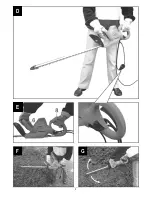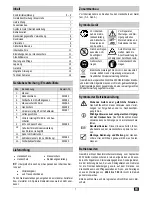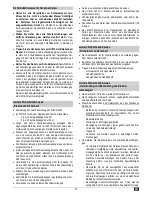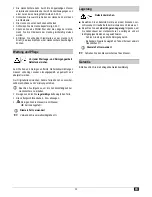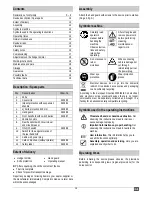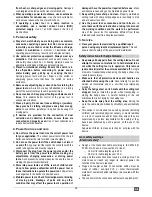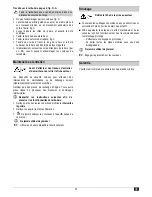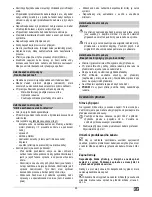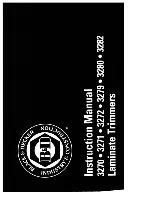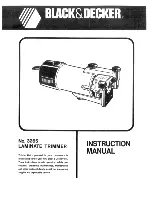
16
from heat, oil, sharp edges and moving parts.
Damaged
or entangled cords increase the risk of electric shock.
e)
When operating a power tool outdoors, use an extension
cord suitable for out-door use.
Use of a cord suitable for
out-door use reduces the risk of electric shock..
f)
If operating a power tool in a damp location is
unavoidable, use a residual current device (RCD)
protected supply.
Use of an RCD reduces the risk of
electric shock.
3. Personal safety
a)
Stay alert, watch what you are doing and use common
sense when operating a power tool. Do not use a power
tool while you are tired or under the influence of drugs,
alcohol or medication.
A moment of inattention while
operating power tools may result in serious personal injury.
b)
Use personal protective equipment. Always wear eye
protection.
Protective equipment such as dust mask, non-
skid safety shoes, hard hat, or hearing protection used for
appropriate conditions will reduce personal injuries.
c)
Prevent unintentional starting. Ensure the switch is in
the off-position before connecting to power source
and/or battery pack, picking up or carrying the tool.
Carrying power tools with your finger on the switch or
energising power tools that have the switch on invites
accidents.
d)
Remove any adjusting key or wrench be-fore turning the
power tool on.
A wrench or a key left attached to a rotating
part of the power tool may result in personal injury.
e)
Do not overreach. Keep proper footing and balance at all
times.
This enables better control of the power tool in
unexpected situations.
f)
Dress properly. Do not wear loose clothing or jewellery.
Keep your hair, clothing and gloves away from moving
parts.
Loose clothes, jewellery or long hair can be caught in
moving parts.
g)
If devices are provided for the connection of dust
extraction and collection facilities, ensure these are
connected and properly used.
Use of dust collection can
reduce dust-related hazards.
4. Power tool use and care
a)
Do not force the power tool. Use the correct power tool
for your application.
The correct power tool will do the job
better and safer at the rate for which it was designed.
b)
Do not use the power tool if the switch does not turn it
on and off.
Any power tool that cannot be controlled with the
switch is dangerous and must be repaired.
c)
Disconnect the plug from the power source and/or the
battery pack from the power tool before making any
adjustments, changing accessories, or storing power
tools.
Such preventive safety measures reduce the risk of
starting the power tool accidentally.
d)
Store idle power tools out of the reach of children and
do not allow persons unfamiliar with the power tool or
these instructions to operate the power tool.
Power tools
are dangerous in the hands of untrained users.
e)
Maintain power tools. Check for misalignment or binding
of moving parts, breakage of parts and any other
condition that may affect the power tool’s operation. If
damaged, have the power tool repaired before use.
Many
accidents are caused by poorly maintained power tools.
f)
Keep cutting tools sharp and clean.
Properly maintained
cutting tools with sharp cutting edges are less likely to bind
and are easier to control.
g)
Use the power tool, accessories and tool bits etc. in
accordance with these instructions, taking into account
the working conditions and the work to be performed.
Use of the power tool for operations different from those
intended could result in a hazardous situation.
5. Service
a)
Have your power tool serviced by a qualified repair
person using only identical replacement parts.
This will
ensure that the safety of the power tool is maintained.
S
S
a
a
f
f
e
e
t
t
y
y
i
i
n
n
s
s
t
t
r
r
u
u
c
c
t
t
i
i
o
o
n
n
s
s
f
f
o
o
r
r
h
h
e
e
d
d
g
g
e
e
t
t
r
r
i
i
m
m
m
m
e
e
r
r
s
s
•
Keep away all body parts from the cutting blades. Do not
attempt to remove cut material or to hold material to be
cut while the cutting tool is in operation. Only remove
jammed material after the unit was switched off.
A single
moment of inadvertence when using the hedge shear may
result in severe injury.
•
Make sure that all protective devices and handles are
attached before using the unit.
Never attempt to put into
service an incomplete unit or a unit that was improperly
modified.
•
Carry the hedge shear on its handle with the cutting tool
stopped.
Always install the guard when transporting or
storing the hedge shear. A careful handling of the unit
minimises the risk of injury by the cutting tool.
•
Keep the cable away from the cutting area.
During the
work, the cable may be hidden by shrubbery and accidentally
cut.
•
This device is not intended to be used by persons (including
children) with restricted physical, sensory or mental abilities
or a lack of experience and/or know-how unless they are
supervised by a person responsible for their safety or they
have been instructed by such a person on the use of the
device.
Supervise children to make sure they do not play with the
device.
m
m
o
o
r
r
e
e
s
s
a
a
f
f
e
e
t
t
y
y
w
w
a
a
r
r
n
n
i
i
n
n
g
g
s
s
„
„
E
E
l
l
e
e
c
c
t
t
r
r
i
i
c
c
a
a
l
l
s
s
a
a
f
f
e
e
t
t
y
y
“
“
•
Design of the connection cable according to IEC 60245 (H
07 RN-F) with a core cross-section of at least
−
1.5 mm² for cable lengths up to 25 m
−
2.5 mm² for cable lengths over 25 m
•
Long and thin connection lines result in a voltage drop. The
motor does not reach any longer its maximal power; the
function of the device is reduced.
•
Plugs and coupler outlets on connection cables must be
made of rubber, non-rigid PVC or other thermoplastic
material of same mechanical stability or be covered with this
material.
•
The connector of the connection cable must be splash-proof.



